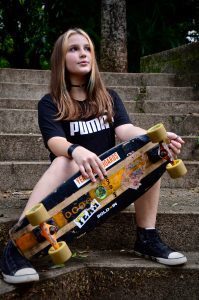Exploring the vibrant world of urban skateboarding? Look no further! Our comprehensive skateboard deck buying guide covers everything enthusiasts need to know. From choosing the ideal skateboard to use in urban boarding to mastering the art of flips and grinds, this article is your go-to resource.

In this skateboard deck buying guide, we’ll cover the fundamentals of a complete skateboard, explaining the different deck options, and exploring the various features of wheels. We’ll also dive into the world of skaters, exploring the principle behind flip tricks and how to find the ideal size based on your shoe size. We’ll discuss the advantages of a wider deck for stability and tricks and the significance of deck width regarding personal preference.
Additionally, we’ll explore the importance of the nose and tail design for versatile maneuvers in skateboarding. We aim to help you discover the perfect street board that complements your style and enhances your skills as you conquer the streets. So, join us as we go through our skateboard-buying guide! Share your valuable feedback with us to let us know your thoughts.
Key Takeaways
This skateboard buying guide will cover the basics of choosing the perfect street skateboards for great urban adventures. It’s not just about style; we’ve discovered many other factors to consider, such as size, performance, construction, and skating style. With a suitable skating board, you’ll be prepared to take on any street that comes your way with our buying tips for street riding.

- Understanding Skateboard Components: A comprehensive understanding of skateboard parts, such as decks, trucks, shapes, wheels, and bearings, is crucial. Our skateboard deck buying guide will help you with that. Deck material, shape, and size impact performance and maneuverability, particularly on urban surfaces.
- Personalization and Style: Selecting a board isn’t just about functionality; personal style, design preferences, and graphic choices play a significant role. The right design enhances the connection with the skateboard and can also provide functional benefits, like additional grip.
- Styles: Different styles, like street skating and transition/vert, require different skateboard types. This emphasizes maneuverability and control in urban environments, while transition or vert focuses on aerial tricks and ramp skills.
- Safety and Maintenance: Safety skateboard gear, including helmets and pads, is essential. Regular maintenance of the skateboard ensures optimal performance and longevity.
- Size and Fit: The right size and fit of the skateboard are essential. This includes deck size, wheel size, and the overall dimensions of the skateboard, which should be chosen based on the skill level, style, and body size.
- Material and Construction: The material and construction of the skateboard affect its durability and performance. Maple decks are known for their strength.
- Performance Factors: Consider aspects like speed, agility, responsiveness, and quality. These depend on deck flexibility, wheel type, and overall build quality of the skateboard.
- Learning and Improving Skills: Practice, patience, and learning from experienced skaters are key to improving your skills. Beginners should start on flat surfaces and gradually progress to more complex maneuvers and higher speeds.
- Choosing the Right Skateboard: When you shop for a skateboard, consider your skating style, your experience level, and your personal preferences in terms of design and functionality for street skateboards.
Skateboard For Urban Cruising Selection Guide
In street skating and performing tricks, street skateboards come in different varieties, including wider decks (greater surface area), harder wheels, and the ability to perform technical tricks. When choosing your skateboard, consider the decks, especially maple decks, known for their durability, and allow you to explore various tricks.
Things You Need To Consider
Remember, finding the right street skateboard that suits your personal preference, skating style, and needs will make all the difference in your skating experience, and our skateboard deck buying guide can assist you in this process. So, get out there for an adventure!
Basics Of A Skateboard
It’s crucial to understand what makes up this rad piece of gear. Skateboard components like trucks, wheels, bearings, and decks are essential to every setup, and it’s important to familiarize yourself with these components. Maintenance and protective gear are also essential. Helmets, knee pads, wrist guards, and elbow pads are key to keeping us safe.
Now that we’ve covered the essentials, let’s focus on identifying your unique style on these urban streets. Skateboards are an incredible way to stay active and have fun with family and friends. With that in mind, these buying tips for street skating will help you in guiding and identifying the right setup for your needs.
Determine Your Skateboarding Style
Let’s dive into the exciting world of skateboarding styles. Primarily, we’ll focus on two contrasting but equally thrilling forms: skateboarding and transition or vert skateboarding. These styles define your approach and significantly influence the type of skateboard you choose.
Skateboards For The Urban Environment
Street skateboarding is an exhilarating expression of creativity and skill, utilizing the urban environment as a canvas for impressive tricks and maneuvers. This style is characterized by its focus on ground-level obstacles like stairs, rails, curbs, and ledges. It requires a skateboard that offers precision, agility, and durability to withstand the demands of urban surfaces. Typically, a street skateboard has smaller, harder wheels for better control and response, and a narrower deck for easier flip tricks.

As you dive into skateboarding, you’ll learn to master the art of ollies, kickflips, and grinds, all while navigating through the concrete jungle. This style is not just about physical skills but also about an attitude and approach to skateboarding that celebrates creativity, innovation, and the use of urban spaces in new and exciting ways. And for those who crave an added rush, venturing into transition or vert skateboarding awaits, propelling skating into a whole new dimension – an exciting twist on this sport!
Transition Or Vert Skateboarding
Transition or Vert Skateboarding takes the thrill to new heights, focusing on ramps, bowls, and half-pipes. This style is about aerial tricks, smooth transitions, and maintaining flow on curved surfaces. Skateboards for transition or vert skateboarding typically feature wider decks for greater stability in the air and softer, larger wheels for better grip and smooth ride on ramp surfaces.
Learning transition skateboarding involves mastering techniques like carving, pumping, and aerial tricks such as airs, grabs, and spins. It’s a style that combines the physical demands with the exhilaration of flying through the air, challenging skaters to push the limits of what they can do. Whether you’re dropping into a half-pipe for the first time or perfecting your vert skating skills, transition skateboarding offers a unique and thrilling experience that tests both courage and skill.
Skateboard Deck Size
Choosing the right deck size isn’t just about comfort; it’s also about mastering your tricks and maintaining control while navigating city streets, especially based on your shoe size. Deck durability is key for harsh urban surfaces, and a customizable deck can help with the terrain you’re on.
- Match Deck Size With Shoe Size: Select a skateboard deck size that complements your shoe size for optimal control and comfort while performing tricks and navigating city streets, catering to style and personal preferences.
- Deck Durability: Choose a skateboard deck made from sturdy materials, such as multi-layered maple, to withstand the point wear and tear of harsh urban environments.
- Control And Maneuverability: Choose a skateboard deck size that offers easy control and maneuverability, essential for mastering tricks and navigating through city obstacles.
- Customizable Skateboard Decks: Consider a deck that offers customization options to adapt to different urban terrains and personal styles.
- Width Of The Deck: A wider skateboard deck with more surface area can provide more stability when doing certain styles, especially when cruising on uneven urban riding style surfaces. Standard boards are ideal for street skaters. Narrower skateboards are ideal for technical tricks. The choice can vary on the rider’s personal preference and skating style.
- Concave For Better Grip: Look for a skateboard deck with the right concave shape to enhance foot grip, crucial for executing precise tricks and maintaining control.
- Personal Style And Graphics: Choose a board deck with a design and graphics that reflect your style, adding an element of personal expression to your experience.
- Deck Length For Different Styles: Consider the length of the skateboard deck to the style you prefer, as some maneuvers may require a longer or shorter deck for optimal performance.
Skateboard Wheel Size
When it comes to wheel size, you’ll find that it significantly influences the performance of your skateboard. A larger skateboard wheel provides speed, while a smaller one offers maneuverability. Additionally, wheel durability and bearing quality are essential for smooth rides and a longer lifespan. Understanding these wheel size aspects can help you better serve others with your skills.
- Larger Skateboard Wheels for Speed: Choose larger skateboard wheels if you prioritize speed, as they help maintain momentum and cover more ground quickly.
- Smaller Skateboard Wheels for Maneuverability: Opt for smaller skateboard wheels to enhance maneuverability and precision, especially useful for performing intricate tricks.
- Wheel Durability: Select skateboard wheels made from durable materials to withstand regular use and various surfaces, ensuring a longer lifespan for your wheels.
- Quality of Bearings: Invest in high-quality bearings for your skateboard wheels, as they contribute to a smoother cruise and better overall performance.
- Wheel Hardness (Durometer): Consider the hardness of the skateboard wheels (measured in durometer), as this affects grip and feel on different surfaces.
- Wheel Material: Look for skateboard wheels made from quality urethane for a balance of grip, durability, and performance.
- Wheel Size and Style: Match the wheel size to your style, with larger wheels being more suitable for cruising and smaller wheels for technical use.
- Impact On Technique: Understand how wheel size affects various techniques, such as the ease of performing ollies, slides, and grinds.
- Customizing Wheel Setup: Customize your skateboard wheel setup to suit your specific needs, whether it’s for speed, tricks, or cruising, to enhance your experience and skills.
Skateboard Performance
Speed often takes center stage, but it’s only part of the equation. Agility, responsiveness, and the ability to carve smoothly around tight corners are equally critical. The ride quality, determined by factors like deck flexibility and wheel type, can significantly influence comfort, especially over varied terrains.
Routine maintenance is important. Check the decks, trucks, wheels, bearings, and hardware. Clean and lubricate the bearings. A well-maintained board can greatly extend its lifespan and ensure top performance. It’s essential to prioritize safety in terms of the board’s build quality and the protective gear you wear.
While functionality remains paramount, aesthetics shouldn’t be overlooked. The design of the board, its graphics, and its overall appearance can be a reflection of your style. As you select, consider aspects like speed potential, durability, deck size, materials, and craftsmanship. A well-chosen skateboard is both a performance tool and a personal statement.
Street Skateboard: Design Preferences
Skateboarding, beyond its functional aspects, offers an avenue for self-expression. Choosing a design that resonates with your style can significantly enhance your connection with the board. From vivid colors to intricate graphics, the possibilities are endless. Skateboards have evolved from mere modes of transportation to canvases of personal identity.
Whether it’s an artwork representing your favorite subculture, a nod to a beloved band, or even a custom-made design, your skateboard can speak volumes about your tastes, interests, and ethos. However, design preferences shouldn’t be purely cosmetic. They can serve functional purposes, too. Some graphics, for instance, come with textured finishes that provide additional grip, facilitating better control during rides.
The layout and placement of graphics can also help riders identify the board’s nose and tail, which are crucial for performing certain tricks. While choosing your skateboard’s look, ensure that the designs mirror your style and enhance your skateboarding by contributing to the board’s overall performance. Remember, a well-chosen skateboard marries aesthetics with functionality seamlessly.
Graphic Choices
Graphic choices are essential and can make a statement about your skate style. Express yourself and let your skateboard reflect your personality. Let’s explore the world of skateboard design and look at some design elements to consider.
- Sticker placement: Strategically place stickers. These skateboard accessories highlight your personality and make a statement.
- Artist collaborations: These unique designs reflect creative partnerships between brands and artists.
- Brand logos: Showcase your preferred brands through logo placement.
- Graphic themes: Choose characters or motifs that resonate with you to customize your skateboard further.
Color and design are key elements of skateboard graphics, and depending on your selection, you can create a complete look that expresses your style.
Skateboard Color And Design Options
Exploring the color and design options for your deck is like embarking on a vibrant skateboard journey, where each shade and pattern can uniquely represent your identity. When choosing colors for your skateboard, think about how color psychology can reflect your personality on the streets. The hues you pick for your skateboard are not just about aesthetics; they’re a form of self-expression in the skateboarding world.
As you design your skateboard, let your passions and hobbies guide your choices, making your board a true reflection of your style. Remember, every component of your skateboard, from the deck to the trucks and wheels, contributes to its overall look and feel. Your skateboard’s design isn’t just about the visual appeal; it’s about making your skateboard an extension of your style.
Incorporate style, design, customization, and texture into your skateboard’s color and pattern choices. By integrating these elements with your distinct style, you’re not merely maneuvering a skateboard; you’re navigating with a piece of art that embodies your identity in the urban scene. A skateboard that resonates with your style enhances the joy and excitement of every adventure.
Conclusion
Skateboarding isn’t just about rolling on four wheels. It’s a lifestyle, a medium of expression, and a way to navigate the urban jungle with panache. While style undoubtedly plays its role, the essence of a good skateboard lies in its size, performance, construction, and how it aligns with the rider’s style and needs. Embracing the world of skateboarding equips you with the power to turn any pavement into your playground.
Whether you’re seasoned in maneuvering or are lacing up for your first ride, we’d love to hear how this skateboard-buying guide has influenced your choice of skateboards, longboards or street skateboards. Remember, the universe of skateboarding is vast and varied—from agile shortboards to the cruising elegance of longboards and the technological marvel of electric boards, including street skateboards tailored for your urban escapades. Whether you’re looking for longboards, cruiser types, or standard boards, we hope you find our information useful. Whatever your preference, there’s a skateboard tailored for your urban escapades.
Frequently Asked Questions:
How Do You Know If Your Board Is Loose?
Determining whether your skateboard is loose often revolves around the performance of its trucks. Excessive wobbling during rides or overly easy and unstable turning are common indicators of loose trucks. To check, flip the skateboard and push the wheels to one side; if they turn effortlessly with significant lean, your trucks may indeed be too loose.
Adjusting the tightness of your trucks can enhance stability and control, ensuring a smoother experience as you execute various tricks or cruise on your skateboard. Consider factors such as board length, wider decks, and mellow concave to tailor your setup to your preferences.
Additionally, factors like the size of the skateboard, both in terms of width and deck dimensions, play a crucial role. Larger wheels on a wider board can affect how the skateboard performs, and choosing the right combination based on your height and shoe size can significantly impact your overall experience.
Pay attention to details like wood grain, cruiser boards, and standard characteristics, as they contribute to the feel and maneuverability of your skateboard. Understanding these elements allows you to fine-tune your skateboard setup for optimal performance and a more enjoyable ride.
What Factors Increase The Risk Of Injury?
Factors that increase the risk of injury include not wearing protective gear, skating on uneven or busy terrains, attempting tricks beyond one’s skill level, using a poorly maintained skateboard, and not learning proper falling techniques. External factors like weather conditions and traffic can also contribute to the risk.
How Do You Choose The Best Skateboard For You?
When choosing a skateboard, focus on key aspects. A wider deck offers enhanced stability. Softer wheels ensure smoother rides. Well-crafted trucks allow for easy turns, beneficial for beginners. Additionally, prioritize high-quality grip tape and opt for reputable brands recognized for their durability. Many high-quality brands offer free shipping for their skateboard. Do research and consider reviews. Add to cart the option that best fits your style.
Consider factors like board width, length, and the type of deck, whether it’s a longboard, cruiser board, or a typical complete skateboard and riding style. A wider deck might be preferable for those interested in more technical tricks or skating ramps. A thinner deck, on the other hand, may suit a specific skating style. To determine the appropriate skateboard size, a deck size chart can help you. Ultimately, tailor your choice to match your personal preference and the skating style you plan to engage in.
What Is The Normal Stance Of Skateboarding?
The “normal” stance in skateboarding is with the left foot forward, known as “regular.” However, some skateboards with the right foot forward are called “goofy.” The best stance is whichever feels most natural and comfortable for the individual. When it comes to choosing the right skateboard, size matters. The size, not just the length, plays a crucial role in determining the rider’s experience. While most boards fall within a standard range, most skaters find their sweet spot by considering factors beyond length.
How Do You Get Better At Skateboarding?
Skateboarding can be improved via regular practice, learning from errors, and observing more seasoned skaters. Consider taking lessons and filming your sessions to analyze your technique. Challenge yourself with new tricks and terrains as your skills progress. Additionally, pay attention to the size of the skateboard, as it can significantly impact your performance.
Experiment with different sizes to find the one that suits you best, focusing on factors like deck width and wheelbase. Remember that size, not length, plays a crucial role in achieving the optimal setup for your style.
How Can You Determine If A Skateboard Is Good For Your Needs?
Is There A Way To Ride A Skateboard Safely?
To ride safely and master tricks, always wear protective gear, including helmets, elbow pads, knee pads, and wrist guards. Start on flat and smooth surfaces, avoid busy tricks, and be cautious of obstacles. Learn to brake effectively and practice falling techniques to minimize injury during deck construction. Advanced skaters understand the importance of perfect setups for optimal performance and safety.
How Do You Get Used To Skateboarding?
Familiarity with controlled rides comes with consistent practice. Start by pushing and cruising on flat terrains, steadily introducing turns and minor tricks in foot placement. Balance exercises off the board 7 ply maple can also be beneficial. Remember to be patient and take breaks when needed. Many skateboards with advanced tricks are a solid choice for different styles.
Determining when it’s time for a new skateboard involves various factors. It might be a clear signal for an upgrade if you observe prominent cracks or breaks in the deck. Worn-out grip tape can significantly affect your performance, diminishing the board’s overall grip. Unresponsive trucks, despite adjustments or wheels that are too small or exhibit uneven wear. This indicates that your current skateboard might need replacement. There are many high-quality skateboards online. Some with affordable prices and free shipping options.
In buying a new one, considering factors like size, wider boards often provide more stability. The number of ply can make a big difference in your skateboarding experience. Elements like symmetrical shape, carbon fiber construction, positive camber, and average width are crucial. This ensures that your skateboard suits your style, especially if you’re into performing tricks with your back foot.
How Long Does It Typically Take To Learn How To Skateboard Well?
Learning to skateboard is a unique journey for each individual within the skateboarding world. Previous experience, practice frequency, and aptitude are key to learning skateboarding quickly. Size affects learning; smaller decks need more control for tricks. Beginners may favor larger skateboards for slower speeds and more stability.
Experienced skaters might choose boards with steep concaves for complex moves. Keep your skateboard in good condition for a better learning experience. Replace worn-out parts promptly for smoother skateboarding.
DISCLAIMER (IMPORTANT): This information (including all text, images, audio, or other formats on FamilyHype.com) is not intended to be a substitute for informed professional advice, diagnosis, endorsement or treatment. You should not take any action or avoid taking action without consulting a qualified professional. Always seek the advice of your physician or other qualified health provider with any questions about medical conditions. Do not disregard professional medical advice or delay seeking advice or treatment because of something you have read here a FamilyHype.com.
